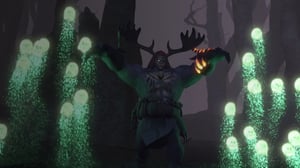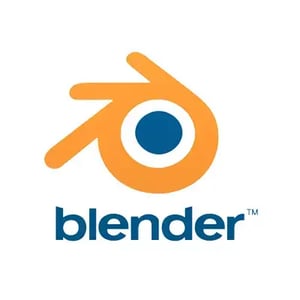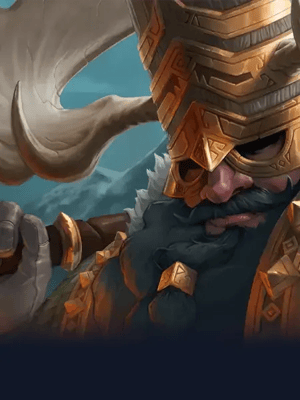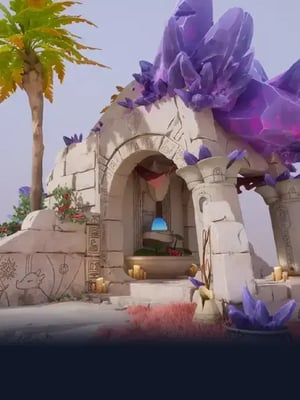
FX Artist - Games
Student work by Tuck Abbot
TABLE OF CONTENTS
What does a video games FX artist do?
A video game FX artist creates digital simulations and procedural workflows based on real-world elements or supernatural concepts that move or react under the basic laws of physics.
There are two main areas of FX in video games:
- Gameplay effects: enhance the action
- Environmental effects: enhance the overall visuals
Composition, scale, form, speed, and viscosity are often taken into account to help determine how an effect looks and reacts to its surroundings. Before creating effects for games, artists are usually required to research real-life phenomena, watch reference videos (when possible), and generate multiple concepts.
Video games FX artist job description
“Power-ups,” fire and lightning, activating a magic forcefield, or even sparkling jewels — these effects (and many more!) are the responsibility of an FX artist.
They also create explosions, destruction, particle systems, and liquid simulations. Their role can also be as broad as generating procedural environments, building basic assets, character effects (cloth, hair, etc.), and solving challenging pipeline problems.
Role & responsibilities of an FX artist in the video games industry:
- Designing and creating FX animation, procedural simulations, dynamic simulations, particle and fluid systems
- Lighting and rendering FX elements and producing composites to showcase ideas and concepts
- Assisting in setting up or maintaining a library of effects presets which can be loaded and applied across an entire game
- Creating tools and code to facilitate automated workflows
- User interface design
FX Lead artist Timucin Ozger has the following simple yet important advice:
“Efficiency is key. Optimization is a must.”

How much does a game FX artist make?
The estimated total pay for an FX Artist is USD 138,106 per year in the Us area, with an average salary of USD 98,692 per year (glassdoor.com).
Skills required to become an FX artist for games
FX artists in games require a mix of technical, creative skills, and interpersonal skills. Basic knowledge of programming software is vital as they need to be able to articulate their technical needs with the game programming teams.
Video game studios may look for the following skills in an FX artist:
- Houdini knowledge and experience (demonstrated via showreel)
- A solid understanding of the video game pipeline
- Organized, particularly with asset management (including naming systems)
- Knowledge of physics and natural phenomena
- A love of playing games and sensitivity to the user experience
What software and tools do game FX artists use?
Game FX artists must be familiar with a game engine. Programming languages VEX and Python are also commonly used in FX
Game FX artists may be required to use some or a combination of the following software:

Blender is a free and open-source 3D computer graphics software tool set. It is used for creating animated films, visual effects, art, 3D-printed models, motion graphics, interactive 3D applications and virtual reality.

Unreal Engine is a 3D computer graphics game engine developed by Epic Games, first showcased in the 1998 first-person shooter video game Unreal

Houdini is built from the ground up to be a procedural system that empowers artists to work freely, create multiple iterations and rapidly share workflows with colleagues.
A day in the life of an FX artist
An FX artist creates computer generated effects elements to integrate seamlessly with live-action footage. A highly in-demand role, FX artists may be required to create fire and smoke, explosions, destruction effects, magic, particle effects, bullet hits, blood, water, oceans, and everything in between. There is no end to the variety of VFX tasks that an FX artist may be tasked with.
If you want to work as an FX artist, you need to understand every step of the VFX pipeline.
The visual effects production pipeline refers to the various stages of production required to add visual effects to a film or video game. The pipeline organizes each department so that every artist knows their role, and a production can move along within the allocated timeline. The production pipeline differs slightly between film and game production, and roles will vary depending on studio size.
FX artists work in post-production, creating simulated elements and making sure that they are added seamlessly to the footage. FX artists work alongside animators to integrate effects such as destruction, fire, liquids, smoke, particle simulations, etc.
How to become an FX artist
To get a job in FX, you’ll need an amazing demo reel! Here are some tips to get you started. Don't forget to check out VFX supervisor Jorge Razon's top demo real and interview tips.
- Students, keep your reel < 1 min. If you have 1–2 years experience, < 2 mins.
- Include any production experience you have.
- Breakdowns are good but keep it to 3–4 quick wipes.
- Always Include breakdown descriptions where applicable.
- Use Vimeo— the video quality is better than YouTube.
- Everything in your reel should be 10/10, do not include mediocre work.
- Keep the music fairly conservative, nobody listens to it anyway.
- Watch your reel a lot of times and look for comp, edit, frame or spelling errors.
- Get feedback from at least 3 instructors or industry pros before releasing online.
- Show reference footage when applicable.
- Share your reel with the world via LinkedIn, Facebook, Instagram.
- Include the Houdini procedural workflow (if applicable) to impress recruiters.
Almost all schools train students to become generalists. If you are applying for VFX jobs at a small studio with less than 30 artists, they will most likely want a generalist. Larger studios will have separate departments, so a more specialized set of skills is desirable.

Ready to Start Your Film & Games Journey?
Download our course guide to see how we can help you on your pathway to your dream career.Tips to break into the FX industry
"The amount I’ve learned in a year studying here is more than I could’ve ever learned in a traditional school or by myself. I could never have dreamed to learn what I know now, and I’m able to apply the strong foundation that CG Spectrum has given me on my future education and career.” -Laura Lekaviciute, Houdini FX student
Increase your chances of getting hired with these strategies for success:
Download software
Trial VFX programs like Maya, Nuke or Houdini Apprentice.
Build skills
Build the skills companies are listing on job sites. For more support, enroll in a reputable course. CG Spectrum’s FX courses include mentorship from VFX pros and an industry-led curriculum.
Watch trends
Online tutorials, webinars, and events can help keep your skills fresh.
Network
Networking is vital. Familiarize yourself with the industry and build your community. Interact online and in real life with industry pros who might offer advice, insights, or job opportunities.
Intern
Internships at VFX or game studios can help you break into the industry. It’s one way to gain hands-on experience, network, and experience studio life.
Join contests
Practice your skills and create assets for your reel by participating in contests and challenges on sites like The Rookies, and ArtStation.
Share work
Social media is great for showcasing work, building an audience, having your work shared by others, and seen by potential clients and collaborators.

Industry Pathways
Welcome to our brand new series, Industry Paths. Tune in to meet our professional mentors from across the film, games, and visualization industries and hear directly from them about how they got started, what a day in their life looks like, and why they do what they do. In this episode, you'll hear from Daniel Hourigan, CG Spectrum's VFX Manager.
Tips to break into the animation industry
Spend as much time as you can on your best pieces of work. Pick a few and perfect them the best you can for your 3D animation portfolio or demo reel. Show versatility in the types of animations you complete, and demonstrate your ability to portray true emotions through facial animation and accurately emulate weight and physics.
Use the networking opportunities available to animation artists to build up your contacts. This can be one of the best ways to get a job. Searching online, you can find many industry meetups and events, which often include guest speakers like professional artists and software creators. The knowledge gained by listening to these types of guest speakers talk about their personal experiences is irreplaceable.
Read more on creating an animation portfolio or demo reel that stands out or how to get 3D animation projects.


